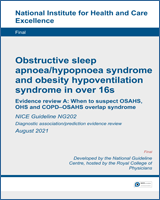From: When to suspect OSAHS, OHS and COPD–OSAHS overlap syndrome

NCBI Bookshelf. A service of the National Library of Medicine, National Institutes of Health.
| Outcomes | No of Participants (studies) Follow up | Quality of the evidence (GRADE) | IRR2 (95% CI) [fully adjusted] | Anticipated absolute effects | |
|---|---|---|---|---|---|
| Risk with Control | Risk difference with patients with type 2 diabetes (95% CI) | ||||
| risk of OSA | N= 360,250 exposed and 1,296,489 unexposed patient cohorts1 |
VERY LOW3 due to risk of bias |
1.36 (1.30-1.42)5 Type 2 diabetes: 3110/360250 (0.88%) Without type 2 diabetes: 1296489/5968 (0.46%) | - | Not estimable4 |
Methods: multivariable analysis. Key covariates included: age, sex, BMI, Townsend deprivation quintile, smoking status and ethnicity.
adjusted incidence rate ratio
Risk of bias was assessed using the QUIPS checklist. Downgraded by 1 increment if the majority of the evidence was at high risk of bias, and downgraded by 2 increments if the majority of the evidence was at very high risk of bias; no indirectness
Data as reported as in the paper
Default MID (0.5XSD) used to assess imprecision. Downgraded by 1 increment if the confidence interval crossed one MID or by 2 increments if the confidence interval crossed both MIDs. GC considered the clinical importance of the effect estimate for each analysis on a case by case basis, taking into consideration the increment of the risk factor and the outcome under study.
From: When to suspect OSAHS, OHS and COPD–OSAHS overlap syndrome

NCBI Bookshelf. A service of the National Library of Medicine, National Institutes of Health.